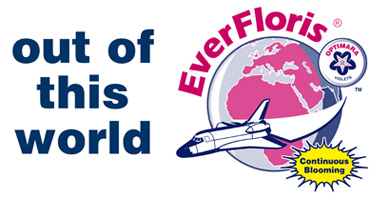|
OPTIMARA EverFloris™
|
Frequently Asked Questions (Everfloris Series and Space Violet program) |
| |
|
- Question
|
"I'm curious, how many of the unique traits that we see in these violets are the result of being in space, and how many are the result of traditional selective breeding?"
|
- Answer
|
We call them "Space Violets" because the results from the space program provided several entirely new traits
to the genes of selectively bred African Violets:
a. Well-Tailored Wavy, Ruffled, Scalloped, Rippled and Overcurling Leaves
b. Additional Flexibility & Durability to Foliage
c. Multi-Florescence - More than One Flower Per Stem
d. Grows 30% to 50% Larger than Standard Varieties |

|
| |
|
- Question
|
"Which of your other plants have the multiflorescence trait that these Space violets have. The description for Optimara Clementine says it's from the space program, so are there any other plants from this program?"
|
Answer
|
We do not have a complete list available at this time, as breeding research has been done in our greenhouses in both American and Germany. However here are 4 varieties with genetic traits from the Space Violet Program.
Idaho Clementine Ontario North Dakota
|

|
| |
|
- Question
|
"How many seeds did you send up,
did you have to do anything special to preserve viability of the seeds
and what as the percentage of viability after 6 years ?"
|
- Answer
|
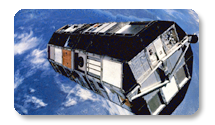 25,000 seeds were sent into space. 25,000 seeds were sent into space.
The 6 inch deep experiment panel in the LDEF was temperature controlled to prevent the seeds from being exposed to harsh extremes of hot and cold, which would have destroyed them. They were inside sealed containers (composed of materials penetrable by cosmic radiation) in a panel on the outside of the satellite.
It is visible in a number of the NASA mission photos.
Amazingly, 80 percent of the seeds germinated, which is a high rate,
but these did not produce a mature or fertile plant.
Of the 20 percent of the seeds producing healthy, viable & mature plants, less than 50 resulted in a plant with traits worthy of cross breeding with other varieties.
|
| |
|
- Question
|
"Was there any attempt to germinate any of the seeds in space?"
|
Answer
|
The experiment in space was simply to expose seeds to cosmic radiation.
|
| |
|
- Question
|
"What seed did you select to send up? Was it all from the same parent plant or from a large or small range of parent plants, of different varieties or a range of them?"
|
Answer
|
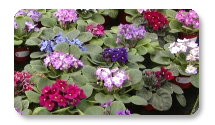
There were hundreds of varieties of African Violet seeds in the experiment. We had the opportunity to send up 25,000, so many different varieties were selected.
|
| |
|
- Question
|
"You mention that the seeds were exposed to cosmic rays for 6 years, did that result in changes to the DNA of the plants? Did the absence of gravity have any effect?"
|
- Answer
|
 The space experiment was to expose the seeds to the radiation of outer space for a period of 11 months. Due to delays they orbited for 72 months! This energy is different than irradiated seeds on earth, the radiation from outer space has many more combinations of wave lengths (particles with origin in our sun, from deep space and from particle interactions in the upper atmosphere), thus many more possibilities for mutation. The space experiment was to expose the seeds to the radiation of outer space for a period of 11 months. Due to delays they orbited for 72 months! This energy is different than irradiated seeds on earth, the radiation from outer space has many more combinations of wave lengths (particles with origin in our sun, from deep space and from particle interactions in the upper atmosphere), thus many more possibilities for mutation.
The DNA of the seeds are changed from the radiation, no effect on seeds has been observed from weightlessness. |
| |
|
- Question
|
"Did all the seeds that came back and germinated have the same set of changes?"
|
Answer
|
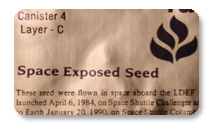 There were a small variety of visible mutations, but no overall trend. It is likely there are other mutations in the plants which are metabolic or biochemical and not visible to the eye, but full genetic mapping & comparison has not been done. Only the space plants with specific desirable traits were crossed with existing varieties to produce a final selected variety. There were a small variety of visible mutations, but no overall trend. It is likely there are other mutations in the plants which are metabolic or biochemical and not visible to the eye, but full genetic mapping & comparison has not been done. Only the space plants with specific desirable traits were crossed with existing varieties to produce a final selected variety.
|
| |
|
| |
- Question
|
"Did the NeverFloris varieties come from this space-exposed seed also?"
|
- Answer
|
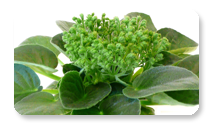
NeverFloris may look a bit "Alien" but is an Earthly variety established in Europe, outside the Optimara space program experiment.
|
| |
|
-
|
|
Thanks to our friends on Facebook for submitting these questions!
Join us there to find out more!
|
| |
|
|




